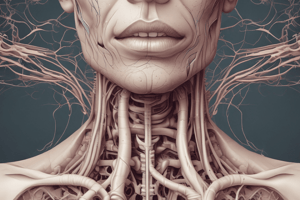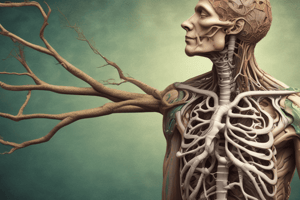Podcast
Questions and Answers
What is the primary function of the mucus in the trachea?
What is the primary function of the mucus in the trachea?
- To provide structural support to the trachea
- To trap dust and microorganisms (correct)
- To expand the trachea during swallowing
- To facilitate gas exchange
Why are smokers more likely to suffer from bronchitis and lung cancer?
Why are smokers more likely to suffer from bronchitis and lung cancer?
- Due to tar covering air passages (correct)
- Because of increased oxygen intake
- Because of reduced blood flow to the lungs
- As a result of damaged alveolar membranes
Which layer lines the thoracic cavity?
Which layer lines the thoracic cavity?
- Mucous membrane
- Pleural fluid
- Visceral pleura
- Parietal pleura (correct)
What type of epithelium is found in the walls of the alveoli?
What type of epithelium is found in the walls of the alveoli?
What is the role of the diaphragm in the respiratory system?
What is the role of the diaphragm in the respiratory system?
Where does gas exchange primarily take place within the lungs?
Where does gas exchange primarily take place within the lungs?
What happens to the air passages when a person smokes?
What happens to the air passages when a person smokes?
What separates the lungs medially in the thoracic cavity?
What separates the lungs medially in the thoracic cavity?
What happens during the process of inspiration?
What happens during the process of inspiration?
What is tidal volume?
What is tidal volume?
Which factor does NOT affect diffusion capacity (DLCO or TLCO)?
Which factor does NOT affect diffusion capacity (DLCO or TLCO)?
What primarily controls the breathing rate under normal conditions?
What primarily controls the breathing rate under normal conditions?
What percentage of oxygen transport is carried by hemoglobin?
What percentage of oxygen transport is carried by hemoglobin?
Which statement about oxygen partial pressure (PO2) at sea level is true?
Which statement about oxygen partial pressure (PO2) at sea level is true?
Which type of receptors are involved in the chemical control of breathing?
Which type of receptors are involved in the chemical control of breathing?
What occurs during expiration?
What occurs during expiration?
Which type of respiration involves gas exchange between blood and body cells?
Which type of respiration involves gas exchange between blood and body cells?
What is the primary function of the respiratory system?
What is the primary function of the respiratory system?
Which structure is NOT part of the Upper Respiratory Tract (URT)?
Which structure is NOT part of the Upper Respiratory Tract (URT)?
What is the role of the epiglottis during swallowing?
What is the role of the epiglottis during swallowing?
Which gas is most abundant in the atmosphere?
Which gas is most abundant in the atmosphere?
Which of the following is a key component of cellular respiration?
Which of the following is a key component of cellular respiration?
What is the main purpose of the mucous membrane in the nose?
What is the main purpose of the mucous membrane in the nose?
The trachea remains open due to the presence of what?
The trachea remains open due to the presence of what?
Flashcards
External Respiration
External Respiration
The process of gas exchange between the blood capillaries and the tiny air sacs in the lungs. Think of it as breathing in oxygen and breathing out carbon dioxide.
Internal Respiration
Internal Respiration
The exchange of gases between the blood capillaries and the body cells. This is where the oxygen gets delivered to the cells and carbon dioxide is taken away.
Cellular Respiration
Cellular Respiration
The process in which cells break down organic molecules, primarily glucose, to release energy. This is how your body gets energy to function.
Nose & Nasal Cavity
Nose & Nasal Cavity
Signup and view all the flashcards
Pharynx
Pharynx
Signup and view all the flashcards
Larynx
Larynx
Signup and view all the flashcards
Trachea
Trachea
Signup and view all the flashcards
Diaphragm
Diaphragm
Signup and view all the flashcards
Ventilation
Ventilation
Signup and view all the flashcards
Inspiration
Inspiration
Signup and view all the flashcards
Expiration
Expiration
Signup and view all the flashcards
Tidal Volume
Tidal Volume
Signup and view all the flashcards
Partial Pressure of a Gas
Partial Pressure of a Gas
Signup and view all the flashcards
Gas Diffusion
Gas Diffusion
Signup and view all the flashcards
Diffusing Capacity of the Lungs (DLCO)
Diffusing Capacity of the Lungs (DLCO)
Signup and view all the flashcards
Oxygen Transport
Oxygen Transport
Signup and view all the flashcards
Why are trachea's cartilages C-shaped?
Why are trachea's cartilages C-shaped?
Signup and view all the flashcards
How does the trachea protect the lungs?
How does the trachea protect the lungs?
Signup and view all the flashcards
How does the trachea connect to the lungs?
How does the trachea connect to the lungs?
Signup and view all the flashcards
How does smoking affect the lungs?
How does smoking affect the lungs?
Signup and view all the flashcards
Describe the location and structure of the lungs.
Describe the location and structure of the lungs.
Signup and view all the flashcards
What are the pleurae and their function?
What are the pleurae and their function?
Signup and view all the flashcards
How do the bronchioles and alveoli contribute to gas exchange?
How do the bronchioles and alveoli contribute to gas exchange?
Signup and view all the flashcards
What happens during gas exchange in the alveoli?
What happens during gas exchange in the alveoli?
Signup and view all the flashcards
Study Notes
Respiratory System Overview
- The respiratory system is a network of tubes that filter and transports air to tiny air sacs (alveoli) for gas exchange.
- The system is divided into the upper and lower respiratory tracts.
- The upper respiratory tract (URT) includes the nose, nasal cavity, and pharynx.
- The lower respiratory tract (LRT) includes the trachea, bronchi, and lungs.
Respiration Definitions
- External respiration: Gas exchange between blood capillaries and air sacs of the lungs.
- Internal respiration: Gas exchange between blood capillaries and body cells.
- Cellular respiration: The breakdown of organic molecules (like glucose) in cells to release energy.
Structures of the Nose and Mouth
- The nose is supported by bone and cartilage.
- The nasal cavity contains hairs that filter air.
- The mucous membrane warms and moistens the air.
- The hard and soft palates separate air from food in the mouth.
- The pharynx (throat) is a common pathway for air and food.
Air Passages and Associated Structures
- The larynx contains the vocal cords.
- The trachea is located in the mediastinum, anterior to the esophagus.
- It is supported by C-shaped cartilages that allow the esophagus to expand during swallowing.
- The inner wall is lined with ciliated epithelium and goblet cells to trap incoming particles, allowing removal by the coughing reflex.
- The bronchi branch into smaller and smaller bronchioles, leading to the alveoli.
- Smokers' air passages get coated with tar, irritating lungs and hindering gas exchange, increasing the risk of bronchitis and lung cancer.
Lungs
- The lungs are spongy, cone-shaped organs that occupy most of the thoracic cavity. They are separated medially by the mediastinum and encased in pleura (visceral and parietal).
- Alveoli (tiny air sacs) have thin walls composed of simple squamous epithelium, facilitating gas exchange with a rich supply of blood capillaries.
- Oxygen moves from alveoli into the blood, and carbon dioxide moves from the blood to the alveoli.
Diaphragm, Ribs, and Intercostal Muscles
- The diaphragm is a large, semi-circular muscle and tendon attached to the base of the ribs and vertebral column.
- Its movement is crucial for breathing, coughing, and vomiting.
- Ribs provide protection to the heart and lungs, and aid in breathing.
- Intercostal muscles move the ribs.
Breathing (Ventilation)
- Breathing is the movement of air into and out of the lungs.
- It involves inspiration (inhaling) and expiration (exhaling).
- The diaphragm and intercostal muscles are responsible for these movements.
- Inspiration involves muscle contraction and expansion of the thoracic cavity, reducing pressure in the alveoli and drawing air in.
- Expiration is the reverse process, with muscle relaxation and a reduction in the thoracic cavity, increasing pressure in the alveoli and forcing air out.
- Breathing rate is primarily involuntary, regulated by the brain, and can increase during and after exercise to remove excess carbon dioxide. Some voluntary control is possible.
Gas Transport and Diffusion
- Partial pressure (P) of a gas in a mixture is the pressure exerted by that gas.
- At sea level, atmospheric pressure is roughly 760 mmHg (101.3 kPa or 1 atmosphere). This influences gas exchange in the lungs.
- Oxygen has a higher partial pressure in the alveoli than in the blood, allowing it to diffuse from the alveoli into the blood. Conversely, carbon dioxide has a higher partial pressure in the blood than in the alveoli, allowing it to diffuse from the blood to the alveoli.
- Gas diffusion across the alveolar-capillary membrane is influenced by membrane thickness, surface area, diffusion coefficient, and pressure gradient.
Gas Transport
- Oxygen transport in the blood is predominantly by hemoglobin (97%).
- A small amount dissolves in plasma and cells.
- Carbon dioxide transport occurs as bicarbonate ions (HCO3-), dissolved CO2, and bound to hemoglobin.
Control Mechanisms
- Neural control: The respiratory centers in the medulla oblongata of the brain control breathing rate and depth, responding to input from various respiratory receptors.
- Chemical control: Chemoreceptors detect changes in blood pH and partial pressures of carbon dioxide (PCO2) and oxygen (PO2) and signal the respiratory centers to adjust breathing.
- Intra-pulmonary receptors: Cough, stretch and C-fibre receptors in the lungs send signals back to the respiratory centers to regulate breathing patterns and prevent damage when exposed to irritants.
Additional Facts
- The total lung volume is approximately 3-5 liters, but tidal volume (air moving in and out per breath) is around 0.5 liters.
Studying That Suits You
Use AI to generate personalized quizzes and flashcards to suit your learning preferences.




